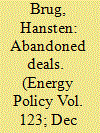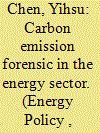|
|
|
Sort Order |
|
|
|
Items / Page
|
|
|
|
|
|
|
| Srl | Item |
| 1 |
ID:
162281


|
|
|
|
|
| Summary/Abstract |
High profile deals emphasize the costs of the merger and acquisition (M&A) process particularly when deals fail before closure. However, beyond anecdotal evidence, we do not know why some M&A deals in the electricity and gas industries are abandoned. We analyze a sample of over 5000 M&As in the electricity and gas industries. The three most important factors affecting M&A abandonment are if the acquirer engaged in a divestiture at the same time, whether the target firm was publicly owned, and if the acquirer already had a toe-hold (part ownership) in the target firm at the time of the M&A deal. An M&A deal is 10.17% less likely to be abandoned if the acquirer engaged in a divestiture at the same time. An M&A involving a publicly owned target firm is 9.87% more likely to be abandoned. Lastly, an M&A in which the acquirer had a toe-hold in the target company is 7.87% more likely to be abandoned. Our findings show that policy makers and practitioners should be aware that the M&A process is affected by often over-looked deal or firm specific factors.
|
|
|
|
|
|
|
|
|
|
|
|
|
|
|
|
| 2 |
ID:
091702


|
|
|
|
|
| Publication |
2009.
|
| Summary/Abstract |
Electricity demand in South Africa has grown at a very rapid rate over the past decade. As part of reform initiatives to enhance long-term sustainability of the country's electricity industry, South Africa's authorities have in recent years sought to develop an electricity pricing framework that is cost reflective and forms the cornerstone of demand management schemes meant to foster changes in consumption behaviour and enhance efficiency in resource use. The effects of any pricing policy on aggregate electricity consumption will depend on a useful understanding of the factors that influence electricity demand, and the magnitude to which electricity demand responds to changes in such factors. In this context, this paper applies the bounds testing approach to cointegration within an autoregressive distributed lag framework to examine the aggregate demand for electricity in South Africa during the period 1960-2007. The results indicate that in the long run, income is the main determinant of electricity demand. With electricity prices having an insignificant effect on aggregate electricity demand, future pricing policies will need to ensure that electricity prices are cost reflective and enhance efficiency of electricity supply and use.
|
|
|
|
|
|
|
|
|
|
|
|
|
|
|
|
| 3 |
ID:
166386


|
|
|
|
|
| Summary/Abstract |
Climate policy has mostly focused on regulating power suppliers. There is a growing interest in exploring regulating emissions from the demand side by incentivizing consumers to reduce their energy consumptions, or to purchase power from cleaner sources through tracking carbon content of power flow in the transmission network. This paper analyzes market outcomes under two approaches: producer-based and demand-based carbon taxes. We formulate each approach as a market equilibrium model. For the consumer-based approach, the analysis assumes that a utility, procuring electricity on behalf of consumers, is subject to the carbon tax. For the producer-based approach, the producers are subject to the carbon tax, and therefore, pay for their emissions. We show that the two approaches are equivalent when the program's coverage is complete. However, when the coverage is incomplete, the consumer-based carbon tax is less effective in pricing carbon emissions owing to the fact that sales to unregulated regions are not subject to the carbon tax. Given that the transaction cost of implementing consumer-based tax is likely to be high, benefit of tracking power flows in order to estimate carbon content or footprint might not be justified even with a full coverage program.
|
|
|
|
|
|
|
|
|
|
|
|
|
|
|
|
| 4 |
ID:
121744


|
|
|
|
|
| Publication |
2013.
|
| Summary/Abstract |
The long-standing severe power shortage in China has provoked much debate on whether China should further promote market-oriented electricity reform. The present paper addresses this issue by analyzing the impacts of deregulation of the electricity generation sector and retailing activities on other sectors, the macroeconomy and electricity users. A counterfactual scenario analysis is used based on a simplified computable general equilibrium framework. We find that deregulation can significantly improve the efficiency of electricity production, increase employment and enhance household welfare. These nontrivial findings can help to resolve many controversies about governmental intervention during China's economic transition. Our findings have two implications relating to policy feasibility and applicability; that is, competition in the electricity retail market should be phased in, and the necessary arrangements for unemployment in incumbent firms should be considered.
|
|
|
|
|
|
|
|
|
|
|
|
|
|
|
|
| 5 |
ID:
171434


|
|
|
|
|
| Summary/Abstract |
Technological progress is an effective way to improve electricity efficiency. Due to the existence of the rebound effect, it is of great significance to optimize the technical power saving policy by examining the rebound effect caused by different technological progress paths.Based on the panel data of electricity industry in 30 provinces of China from 1997 to 2013, this paper systematically examines the rebound effects of electricity consumption under the two sources of technological progress, namely independent innovation and technology import. Then, it discusses the impact of coal-electricity linkage policy. The empirical results are as follows: (1) without considering rebound effect, independent innovation significantly promotes electricity conservation, while the effects of technology import is not obvious; (2) when considering the rebound effect, electricity price declining driven by independent innovation is not conducive to electricity saving, while electricity price declining driven by technology import has an electricity-saving effect; (3)The coal-electricity linkage policy that began in 2004 not only reduced the rebound effect by increasing the flexibility of electricity prices to a certain extent and improved the electricity-saving effect of independent innovation, but also reduced the electricity-saving effect of technology import.
|
|
|
|
|
|
|
|
|
|
|
|
|
|
|
|
| 6 |
ID:
105747


|
|
|
|
|
| Publication |
2011.
|
| Summary/Abstract |
The Australian electricity industry has undergone a significant reform, since the mid-1990s. Key changes comprised functional unbundling, market restructuring, regulatory reform, public corporatisation and privatisation. Technological development has been another indisputable constituent of these changes, in the wake of ICT revolution. The principle rationale behind these changes has been that they would improve productivity of the industry and social well-being of people. This paper examines the dynamics of productivity changes in the Australian electricity industry and conducts several hypotheses-testings to identify whether industry's efficiency measures are truly improved as a result of the reform-driven changes. Malmquist Total Factor Productivity Index approach and ANOVA are used for this purpose. The results reveal that the productivity gains in the industry have been largely driven by technological improvements and, to a lesser extent, by reform-induced comparative efficiency gains. On average at national level and for the entire industry, there are efficiency gains that, to large extents, can be attributed to functional unbundling and public corporatisation and, to a lesser extent, to market restructuring and privatisation. The results, however, reveal that the reform-driven changes have made insignificant contribution to comparative efficiency, at the level of thermal generation.
|
|
|
|
|
|
|
|
|
|
|
|
|
|
|
|
| 7 |
ID:
096617


|
|
|
|
|
| Publication |
2010.
|
| Summary/Abstract |
Australia has been an early and enthusiastic adopter of both electricity industry restructuring and market-based environmental regulation. The Australian National Electricity Market (NEM) was established in 1999 and Australia also implemented one of the world's first renewable energy target schemes in 2001. With significant recent growth in wind generation, Australia provides an interesting case for assessing different approaches to facilitating wind integration into the electricity industry. Wind project developers in Australia must assess both potential energy market and Tradeable Green Certificate income streams when making investments. Wind-farm energy income depends on the match of its uncertain time varying output with the regional half hourly market price; a price that exhibits daily, weekly and seasonal patterns and considerable uncertainty. Such price signals assist in driving investments that maximize project value to the electricity industry as a whole, including integration costs and benefits for other participants. Recent NEM rule changes will formally integrate wind generation in the market's scheduling processes while a centralized wind forecasting system has also been introduced. This paper outlines experience to date with wind integration in the NEM, describes the evolution of market rules in response and assesses their possible implications for facilitating high future wind penetrations.
|
|
|
|
|
|
|
|
|
|
|
|
|
|
|
|
| 8 |
ID:
181434


|
|
|
|
|
| Summary/Abstract |
This article looks at the innovation of European electricity Transmission System Operators (TSOs), which play a key role in meeting growing demand for greener and affordable power and for the development of a smarter and reliable electricity system. Due to the radical transformations occurring in the sector TSOs must increasingly invest in research and innovation and evolve by embracing new technologies, new activities and new business models. This study analyse TSO innovation approach by focusing on projects and initiatives related to some key technologies that are gaining attraction across Europe. The study also investigates whether TSOs operating under more favourable regulatory frameworks for innovation are more innovative than others. The results indicate that TSOs tend to have a conservative approach to innovation, developing projects which have the lowest impact on their current business model, while TSOs operating within more favourable regulatory frameworks are indeed more active than others. These results are aligned with previous studies on electricity network companies according to which they tend to avoid investments in innovative activities, unless they are adequately encouraged or incentivized thus bringing the attention on the urgent need for Regulators and policymakers to review and correct their regulation and incentives for innovation.
|
|
|
|
|
|
|
|
|
|
|
|
|
|
|
|
| 9 |
ID:
167026


|
|
|
|
|
| Summary/Abstract |
While the role of organizational learning in improving firm performance is well documented, there are still questions on what drives technological learning. This is evident in the electricity industry where the growth of renewable energy technologies has been pervasive. Vicarious learning contributes to the adoption of emerging technologies through successful inter-firm knowledge sharing and transfer. However, there is hesitation to adoption that characterizes vicarious learning especially in the context of intra-firm learning. This paper investigates the differences in knowledge acquisition within and across electricity firms in the U.S. The learning curve model is applied to a longitudinal study of 5573 plants belonging to 1542 U.S. electricity firms between 1998 and 2010. This study finds: (i) The capacity growth of the solar photovoltaic technology is positively associated with intra-firm knowledge acquisition; (ii) The effect of financial incentives on the adoption of solar and wind technologies is higher under inter-firm learning; (iii) The higher the stringency of policy mandates, the more varied is the progress on technological change across technologies; (iv) Knowledge sharing between firms are higher for wind technology than for solar technology. These findings combine to show disparities in the learning trends of technologies across and within firms’ boundaries.
|
|
|
|
|
|
|
|
|
|
|
|
|
|
|
|
| 10 |
ID:
150442


|
|
|
|
|
| Summary/Abstract |
The evolution of electricity industry over the last decades has shown substantial differences between OECD countries. This paper empirically investigates to what extent different structural forms of regulation, competition and privatisation explain these international differences. It distinguishes three modes of electricity performance: a) net generation per capita, b) installed capacity and c) labour productivity. The empirical model spans the period 1975–2011 and uses panel data econometric techniques. Our analysis reveals that there is a strongly significant interaction impact on the level of electricity performance between regulation and competition. The empirical findings do confirm that a robust independent regulatory scheme must be implemented in order to achieve a competitive electricity market.
|
|
|
|
|
|
|
|
|
|
|
|
|
|
|
|
| 11 |
ID:
086721


|
|
|
|
|
| Publication |
2009.
|
| Summary/Abstract |
Rapid economic growth and an export driven chemical intesive economic structure have led to a rapid increase in energy consumption. Rapid economic development and the corresponding surge in energy consumption in China have raised public concern.
|
|
|
|
|
|
|
|
|
|
|
|
|
|
|
|
|
|
|
|
|